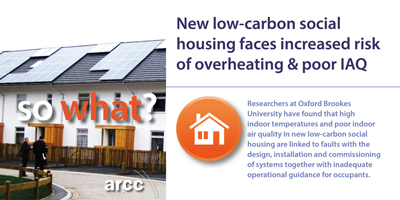Researchers at Oxford Brookes University have found that poor indoor air quality and overheating in low-carbon social housing are caused by social and technical factors, ranging from fabric and system performance to occupant behaviour.
New low-carbon houses are designed to reduce heat loss through improved airtightness and increased insulation, raising the risk of overheating and inadequate ventilation.
A building performance evaluation on six dwellings in three sustainable social housing developments examined overheating risks and indoor air quality (IAQ). High summer indoor temperatures were linked to window opening patterns and faults with the underfloor heating. Poor IAQ was connected to insufficient fresh air supply from the Mechanical Ventilation with Heat Recovery (MVHR) systems due to inadequate commissioning, coupled with inadequate operational guidance and training for occupants.
Relevance
In response to the UK government’s overarching climate change mitigation strategy, targets have been set for the implementation of a revised ‘zero carbon’ dwelling standard in the UK by 2016. As a result, there have been significant changes in the way dwellings are designed and constructed, as regulations require greater energy efficiency.
An emerging body of evidence suggests that serious problems with ventilation and IAQ are evident in many new homes, caused by ineffective ventilation systems that are often poorly specified, installed, commissioned and operated. Furthermore, there is evidence that prototype houses built to zero carbon standards are suffering from overheating. These issues raise questions regarding the unintended consequences of implementing low-carbon strategies on the environmental performance and IAQ of new dwellings.
Findings
- Poor installation and commissioning of MVHR led to system imbalances creating an insufficient fresh air supply, poor IAQ and high energy consumption.
- Occupants do not rely on the MVHR and open windows to improve IAQ, which in turn has a negative impact on energy consumption.
- It is important to integrate a systems and controls strategy early in the design process as there are complex interdependencies between services, systems, controls and occupant behaviour which determine the indoor environment and air quality.
Now what?
In order to effectively map and address IAQ and overheating issues observed in new build low-carbon housing, novel approaches are needed to capture the complexity of the built environment.
Building Performance Evaluation (BPE) is widely acknowledged as an important mixed-method approach for a deeper understanding of the environmental and energy performance of buildings.
With requirements for as-built performance likely to be included in future Building Regulations, the importance of achieving energy and environmental performance that match predictions is becoming a mainstream issue. BPE studies adopt an empirical, forensic and systematic approach to allow a better understanding of the gaps between as-built and actual performance, and how that can be minimised. This is particularly crucial in evaluating actual ventilation and environmental performance.
Relevance
The residential sector in the UK has little historical experience in design, installation or use of the low-carbon systems and technologies that are now widely specified. Limited understanding of these systems leads to failures, breakdowns and misuse, contributing a significant risk to the IAQ and overheating of these houses. Such unintended consequences are poorly understood, and failure to address them can undermine the success of decarbonisation programmes.
BPE is the process of evaluating the performance of a building through a systematic collection and analysis of qualitative and quantitative information related to energy performance, environmental conditions and occupant feedback. Monitoring data on environmental conditions, IAQ and window/door opening are cross-related with the performance of fabric and systems as well as occupants’ understanding, habits and behaviour.
BPE reveals the interdependencies between design specifications, systems and occupants that affect the actual performance of dwellings.
Recommendation
It is vital that there are ‘performance feedback loops’ during the delivery and operation of low-income housing in order to identify and address any faults in services and systems, so that homes perform better than the intended design in terms of energy use, environmental quality and wellbeing of occupants.


